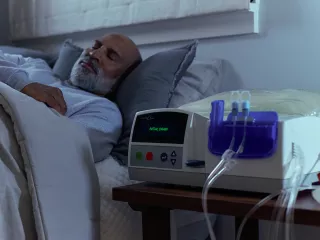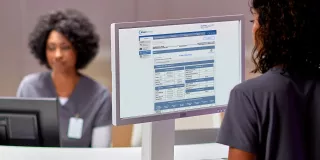
Evidence Supporting Automated Peritoneal Dialysis With Remote Patient Management
A substantial body of evidence endorses the benefits of automated peritoneal dialysis (APD) cyclers with two-way remote patient management technology (RPM).
#1
#2
#3
#4
APD with RPM may reduce hospitalizations
Implementation of APD cyclers with RPM technology may improve clinical outcomes. RPM enables APD patients to have their treatment proactively monitored by nurses and clinicians, without having to spend as much time in the hospital and clinic. This may improve treatment adherence and thus help reduce the risk of complications.2
In a multicenter retrospective cohort study, patients using APD with RPM demonstrated a statistically significant lower rate of hospitalization and duration of hospital stay, compared to patients using APD without RPM.2




Abstract
Remote management technology specifically designed to be integrated into APD systems may improve adherence to treatment and provide the potential for early intervention should therapy complications be encountered.2
Clinical outcomes of incident adult patients treated with APD and RPM were compared to patients treated with APD alone. Patients using APD with RPM had a statistically significant lower rate of hospitalization and duration of stay compared to APD without RPM.2
Rationale
Remote management technology, specifically designed to be integrated into APD systems, offers both patients and their clinical team a powerful tool. Via enhanced communication, the tool may improve adherence to treatment and provide the opportunity for early intervention should therapy complications be encountered.2
The purpose of this study was to compare the hospitalization rates in incident adult patients on automated peritoneal dialysis with and without remote patient management.2
Method
A multicenter retrospective cohort study in incident adult patients performing APD with and without remote monitoring was conducted. Patients were enrolled from October 1, 2016, to June 30, 2017, from 28 renal clinics within the Renal Therapy Service, Colombia network.2
Individuals were matched 1:1 using propensity score matching. The APD therapy with RPM and ADP therapy without RPM groups each yielded 63 individuals. Hospitalizations and days spent in hospital were recorded over 1 year.2
Findings
In the APD with RPM patient group, there was a statistically significant reduction in hospitalizations (39% reduction) and duration of stay (54% fewer days), compared to patients using APD without RPM.2
Implementation of APD cyclers with a remote management program may improve clinical outcomes, such as rate of hospitalization and days spent in hospital.2
RPM may increase time spent on proactive care
APD combined with RPM potentially improves adherence to treatment and provides the potential for early intervention if therapy complications are encountered.
Proactive patient management allows nurses and clinicians to care for and treat their patients with an anticipatory, preventative approach, rather than in a reactive or urgent manner.
An evaluative study showed that when PD nurses implemented RPM, their time spent on proactive patient care activities increased from 2% without RPM to 34.2% with RPM, while the time spent on reactive activities decreased.3

Abstract
RPM systems automate the sending of dialysis data to renal units and allow nurses and clinicians to adjust dialysis cycler programs remotely. To identify whether RPM helps improve patient management and clinic efficiency, four PD nurses were monitored in terms of the proportion of time they spent on proactive, reactive and routine care. Proactive patient care activities increased from 2% of nurses' time without RPM to 34.2% with the implementation of RPM.3
Rationale
New APD cyclers with two-way RPM technology allow nurses to view dialysis details remotely in a timely manner, proactively manage clinical issues and make program changes as necessary. It is important to evaluate the impact of RPM on nurses’ behavior and practice when caring for home-based APD patients and to identify whether RPM helps improve patient management and clinic efficiency.3
Method
Four PD nurses from four UK hospitals were observed prior to implementing APD with RPM (July 2015 – July 2016; before the introduction of APD with RPM) and after implementing APD with RPM (September 2016 – March 2017; 6-13 months after APD with RPM was established).3
A tool was designed to log the time PD nurses spent on different types of task, specifically whether the tasks was:
Proactive: Anticipatory, preventative and change-oriented (e.g., clinician discussions, phone calls/visits to patients and reviewing daily dialysis records)
Reactive: Responsive (e.g., urgent patient consultations and assessments)
Routine: Regular planned activities (e.g., scheduled line changes and review consultations)3
Findings
The amount of time that nurses were able to spend on proactive patient care activities increased from 2% without RPM to 34.2% with RPM. The time spent on reactive patient care decreased from 43.5% to 27% following the implementation of RPM while time spent on routine care decreased by 10%.3
RPM may be an effective method of increasing the time nurses spend on proactive care by reducing time spent on routine and reactive care.3
Vantive and Sharesource are trademarks of Vantive Health LLC or its affiliates.
Important Safety Information
INTENDED USE
The Sharesource Connectivity Platform portal is intended for use by healthcare professionals to remotely communicate new or modified treatment parameters with compatible dialysis instruments and transfer completed treatment data to a central database to aid in the review, analysis, and evaluation of patients’ historical treatment results. This system is not intended to be a substitute for good clinical management practices, nor does its operation create decisions or treatment pathways.
Rx Only. For safe and proper use of the products mentioned herein, please refer to the appropriate Operator’s Manual or Instructions for Use.
References
-
Firanek C, Salas M, Gellens M, Gatesman RD, Wiebenson D, Sloand J. Discrepancy between prescribed and actual APD prescription delivery: Identification using cycler remote management technology. Neph Dial Trans. 2017;32(suppl 3):iii633.
-
Sanabria M, Buitrago G, Lindholm B, et al. Remote patient monitoring program in automated peritoneal dialysis: impact on hospitalizations. Perit Dial Int. 2019;39(5):472-478.
-
Wood E, McCarthy K, Roper M. Remote monitoring of peritoneal dialysis: evaluating the impact of the Claria Sharesource system. J Kidney Care. 2019;4(1):16-24.
-
Firanek C, Knowles M, Sloand J. Impact of remote patient management in hospitals conducting APD: shifting the nursing care paradigm. Neph Dial Trans. 2017;32(suppl 3): iii300.
